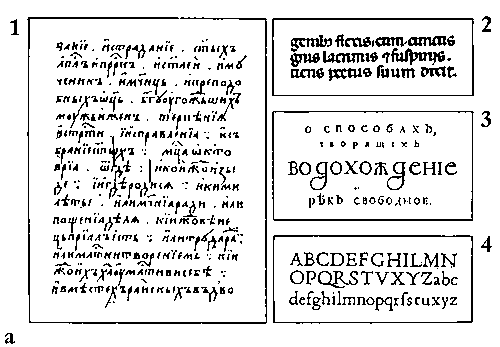Futura (ParaType) Cyr Futura PT (ParaType) Cyr Futura Futuris (ParaType) Cyr Alphatura (Alpha) Century Gothic (Monotype) Cyr Factor (MacCampus) Cyr AG Fatum (Tilde) Cyr Favorit (DoubleAlex) Cyr Fortuna (SoftUnion) Cyr Fortuna (TypeMarket) Cyr Frusta (N&L) Cyr Fujiyama (Corel) Fusion (Anonymous, © 1992) Cyr Fusion (AzZet) Cyr FutMee (TyGra) Cyr Futura (Bauer) Futura TL (Bitstream/Tilde) Cyr AZ Futura (AzZet) Cyr Futura (Tilde) Cyr Futura (URW++) Cyr Futura (!22! Soft) Cyr a_Futurica (Arsenal) Cyr a_FuturaOrto (Arsenal) Cyr a_FuturaRound (Arsenal) Cyr Future (Alpha) Futuris (Panda) Cyr GlasnostFWF (Cassady & Green) Cyr GraphicusDT (DTP Type) Cyr Model (IpexR) Cyr Sans Serif (Cassady & Green) Sparta (Autologic) Spartan (Linotype) Technical (Info) XX Century (Monotype). Cyr OpiumNew (TypeMarket) Cyr Athena (Auto) URW Classico (URW++) Cyr Exyle (Intermicro) Cyr Musica (Alpha) October (Scangraphic) CG Omega (Agfa) Opal-Univer (AS, 1992) Cyr Opium (TypeMarket) Cyr OptCyrillic (AG Baltia) Cyr Optima (AG Baltia) Cyr Optima (Night Graphics) Cyr Optimal (!22!) Cyr Optimist (Auto) AG Opus (Tilde) Cyr Ottawa (Corel) SolaireDT (DTP Type) Cyr Silver Humana (Silver Mountain Software) Cyr Theme (IBM) Variant (DoubleAlex) Cyr Vera Humana 95 (BX Fonts) Cyr Zapf Humanist 601 (Bitstream/Tilde) Cyr.
Apr 22, 2014 - The Journal Sans typeface was developed in the Type Design Department of SPA of Printing Machinery in Moscow in 1940–1956 by the group.
Erbar Geometric sans-serif Date released 1922-30, In, Erbar or Erbar-Grotesk is a typeface in the style, one of the first designs of this kind released as type. Designer aim was to design a printing type which would be free of all individual characteristics, possess thoroughly legible letter forms, and be a purely typographic creation. His conclusion was that this could only work if the type form was developed from a fundamental element, the circle. Erbar-Grotesk was developed in stages; Erbar wrote that he had originally sketched out the design in 1914 but had been prevented from working on it due to the war. The original version of Erbar was released in 1926, following Erbar's 'Phosphor' titling capitals of 1922 which are very similar in design. Contents • • • • • • • Font [ ] Erbar was originally cast by the foundry of, with machine composition matrices later being offered by German and then American. Erbar was later exported to the United States and sold by the.
A digital version is sold today. Erbar was cast in four weights with italic and condensed faces. Other variants were offered: • Lumina, an open face version. • Lux, a version with contrasting outlines. • Phosphor, an ultra-bold/inline display version similar to, released slightly before Erbar itself.
Gallery [ ] •. Erbar Condensed and Phosphor, as well as some other typefaces designed by Jakob Erbar. A leading unofficial Erbar digitisation is Dunbar, released by CJ Dunn in late 2016 as an unofficial digitisation in a choice of named Dunbar Low, Dunbar Text and Dunbar Tall. It is also offered as a, in which the x-height and the weight can be varied smoothly, and as such is the first variable font on sale.
As of 2016, several Erbar digitisations exist under this name. Has released a revival of seven weights (of the normal width only), and a 'Neo Mini' digitisation optimised for small sizes, with an enlarged x-height and solid weight. Has digitised light and bold weights of the condensed style.

Stephen Coles, an expert on digital fonts, has been critical of the Erbar digitisations on the market, writing that 'there is no recommendable digital version.existing revivals neither capture the spirit or breadth of the original family. Still, if you really have a Erbar hankering, URW’s version is the most complete.' Because of Phosphor's popularity, several revivals exist independently of the latter Erbar rereleases (none of which include it), by Monotype and others.
For further information see the section 'Licensing' at the bottom of the page. Simatic step 7 price. • Programming. • Specifying the communication. STEP 7 Basis By employing STEP 7 Basis you can program the SIMATIC S7-300, S7-400, SIMATIC C7 and SIMATIC WinAC automation systems easily and conveniently. STEP 7 contains functions for all phases of an automation project: • Configuring and parameterizing the hardware.
Phosphate, an unofficial revival created by Red Rooster Fonts, is bundled with OS X. Zamenhof, by CastleType, is a large revival inspired by Russian adaptations of the style. Zhurnalnaya roublennaya has itself been digitised by Grilli Type as GT Eesti and (much more loosely) for ParaType as Journal Sans by Olexa Volochay, Maria Selezeneva. See also [ ] •, a popular typeface resembling Erbar References [ ]. • Kupferschmid, Indra. Retrieved 20 October 2016.